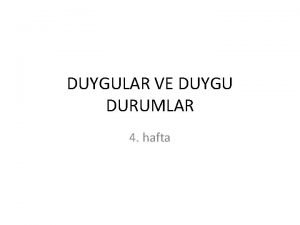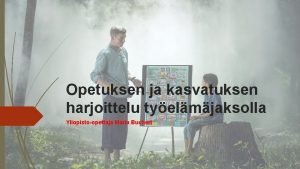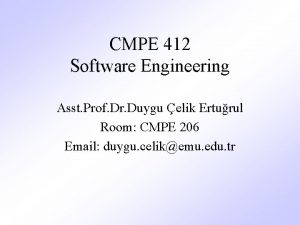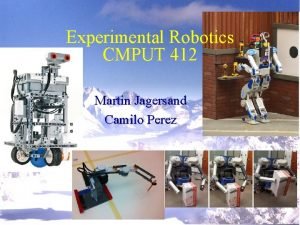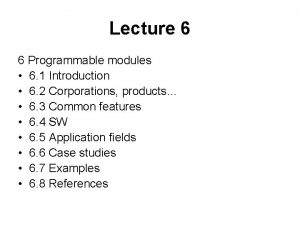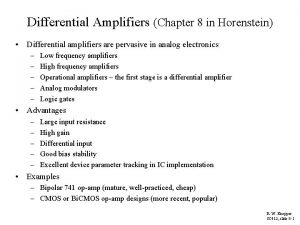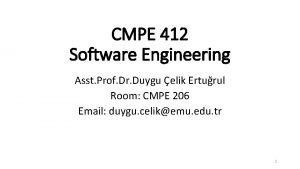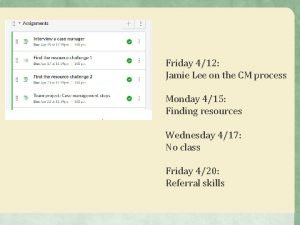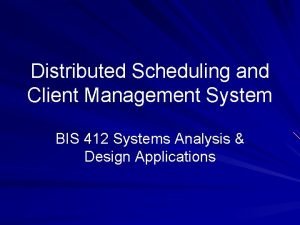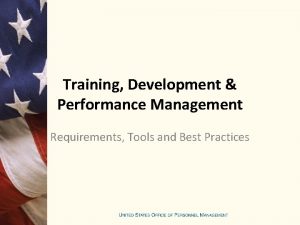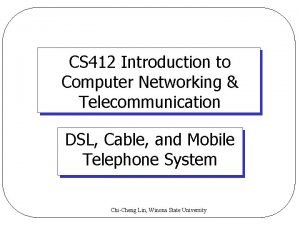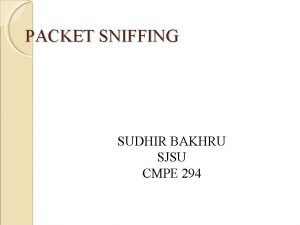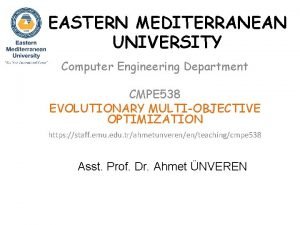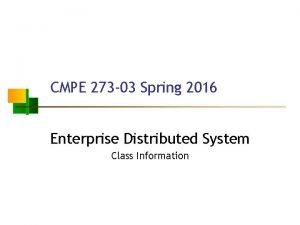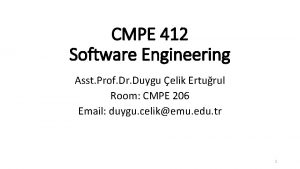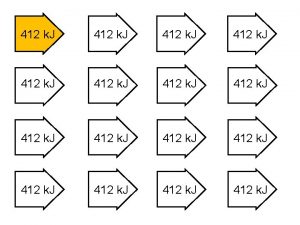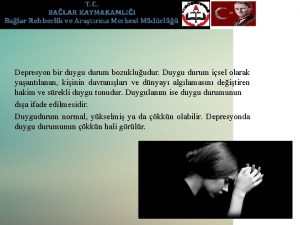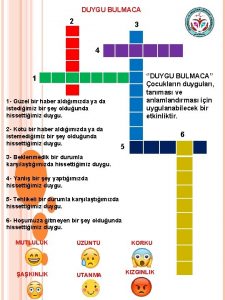CMPE 412 Software Engineering Asst Prof Dr Duygu




































- Slides: 36

CMPE 412 Software Engineering Asst. Prof. Dr. Duygu Çelik Ertuğrul Room: CMPE 206 Email: duygu. celik@emu. edu. tr 1

Project Metrics • In a software Project, we can use measurement to: a) b) c) d) estimate amount of work completed control quality assess productivity control the project Metric: a quantitative (countable) measure of the degree to which a system, component, or process possesses a given attribute. For Example: While developing software, a series of reviews will take place. We can talk about ‘the average number of errors found per review’ as a software metric. 2

• Indicator: a metric, or a combination of metrics that provide insight into the: • software process, • a software Project or Product. • Measurement makes a process more formal and scientific. • Unfortunately, in SE measurement is not applied well enough. • If we make proper measurements on software metrics, then we can: a) Assess the status of the Project, b) Track potential risks and problems, c) Deal with problems before they become critical and harder to solve, d) Adjust work flow of tasks, making changes in the project schedule if needed, e) Evaluate the quality of the work produced. 3

Process Metrics and Software Process Improvement Factors that influences the software quality and organizational performance 4

Quality & Performance • The skill and motivation of people is the most influential factor in quality and performance. • The complexity of the product may reduce the quality and the performance. • The SE technology used (methods) also has an impact an quality and performance. The process triangle sits in the middle of some environmental conditions: a) development environment (e. g. SE tools) b) business condition (e. g. deadlines, rules) c) customer characteristics (e. g. availability, communication) easo of 5

Project Outcomes that can be derived from the Process in triangle: a) b) c) d) e) f) Errors uncovered before release of software Defects reported by end users Work products delivered Human effort spent Calendar days spent Conformance to the Project Schedule In Measuring Defect Rates: a) Defect rates by individual b) Defect rates by module 6

ØSince human beings are all different, one method that is effective for one engineer may not be suitable for another one. ØHumphrey has proposed a ‘personal software process (PSP)’ approach to measure and track one’s own work. ØSo, each individual engineer can find the methods that are the best for him/her. 7

ØProcess metrics can provide important information on a software project, and improve the process. ØHowever, if misused, process metrics may generate more problems than they solve ! ØGrady has suggested the following to use process metrics properly: a) Provide regular feedback to individuals and teams who collect the metrics b) Don’t use metrics to threaten individuals or teams (Metrics should not be used to evaluate the performance of individuals) c) Make clear which metric values must be achieved by individual or teams d) Don’t take a single metric by itself without considering other important metrics. 8

Software Failure Analysis (it is used by Statistical Software Process Improvement (SSPI) techniques) 1. Categorize all errors / defects by their origin. (errors in specification, errors in logic, nonconformance to standards, etc…) 2. Record the cost to correct each error/defect. 3. In each category, count and order in descending order the number of errors/defects. 4. Compute the overall cost of errors/defects in each category. 5. Analyze the resulting data to find out categories with the highest cost in the organization. 6. Develop plans to modify the process such that the most costly errors /defects are reduced/eliminated. 9

From: Pressman, 5 th ed. , p. 85) 10

Project Metrics Project metrics are used by a Project manager or a team to adapt Project work flow and technical activities. • The first application of Project metrics occurs during estimations: ‘using metrics collected from past projects, make effort and time duration estimates for the current Project. ’ • As the project proceeds; measure the efforts and calendar time spent, and compare these values with the estimates. (Check the Project Schedule: are you on-time? ) 11

Other Production Metrics: a) b) c) d) e) f) g) h) i) j) Pages of documentation produced Source lines of code produced Function points delivered Review hours spent If(condition){ //then branch } else { //else branch } k) If(condition){ //then branch} else { //else branch} By looking at these, make adjustments/changes (if necessary), so that: • possible delays are avoided, and • potential problems & risks are addressed as early as possible, • Also, using these metrics, we can improve the quality, and minimize the number of errors. 12

Software Measurement 1. Direct Measures: Lines of code produced Memory size the product occupies Execution speed km/hour; miles/hour; operations/second; GFLOP/S; G – 10^9 Measure operaions number/execution time Start_time; end_time; execution_time=end_time-start_time<=1 sec OK!; response time § NFR 1: In 1 sec confirmation shall be completed § Defects reported over some period of time § § § 2. Indirect Measures: § § § Quality of the code Complexity Efficiency of the code for some data Reliability Maintainability 13

14

• Product Metrics that are private to an individual are often combined to develope project metrics that are public to a software team. • Then, project metrics can be combined to create process metrics that are public to the software company. • How to combine metrics coming from different individuals or projects? • We have to ‘normalize’ the measures ve. g. more bugs will be generated in complex project. v. So, we need some normalization with respect to project complexity. 15

Size-oriented Metrics: Create a table which includes lines of code and other parameters for different projects completed. Project Name Effort Lines Of Code (per*/mon) Pages Of Document Errors Defects People Works A 12. 100=12. 1 KLOC 24 168. 000 365 134 29 3 B 27. 200 62 440. 000 1224 321 86 5 C 20. 400 43 314. 000 1050 256 64 6 For normalization: use ‘Lines Of Code’ For Example: Cost$ • Instead of the ‘raw’ errors metric, we can use the normalized ‘errors per 1000 lines of code’, OR, 24 person*month/4 person= 6 months • Instead of raw ‘cost’, we can use the normalized ‘cost per line of code ’. • A => 134/12=11; <=B=> 321/27= 12; <= C=>256/20= 12. 8 • A=> 14000; B=>15000; C=> 15100 We also use Effort ‘person/months’ for normalization, and we can compute • Errors person-month • Lines of code person month An error is some flaw in a software engineering work product or deliverable that is uncovered by software engineers before the software is delivered to the end-user. A defect is a flaw that is uncovered after delivery to the end-user 16

v. There are people who prefer ‘Kilo-lines of code’ as an appropriate ‘key measure’. v. They say: a) LOC can be easily be counted b) Many existing software size estimation models use LOC as a key input c) There is a lot of literature on LOC. v. Other people think that: a) LOC is dependent on programming language b) It penalizes/ fines well designed but shorter programs c) It is no good for nonprocedural languages 17

• KLOC SLOC KDSI K=2^10=1024 =1000; • M=2^20; G=2^30; T=2^40 18

Function Oriented Metrics • We can use a measure of the functionality delivered by the project as a normalization value. • Functionality cannot be measured directly. So, it must be derived indirectly using other direct measures. • Albrecht suggested using ‘FUNCTION POINTS’ in 1979. (FP) • A Function Point result is just a number. • It does not directly correspond to any program source code size. • Instead, it gives a basis to compare program requirements, design, or final program size independent of chosen design and implementation details. • It can be used to estimate the size of the final program by using a specific conversion table between Function Points and program code size (LOC/FP). • It can also be used to estimate project effort (FP/person-month). 19

Function Points Calculation From Pressman, 5 th ed. , p. 90 20

21

LOC/FP relationship • The relationship between lines of code and function points depends on the programming language • The following table is from Pressman, 5 th ed. , p. 94, gives rough estimates of the Avg. no. of LOC required to build ONE FP in various programming languages 22

Function Oriented Metrics • Once these data have been collected, a complexity value is associated with each count. Organizations that use function point methods develop criteria for determining whether a particular entry is simple, average, or complex. Nonetheless, the determination of complexity is somewhat subjective • Function Points are always an estimation. • Thus, different people may get the somewhat different FP values of the same problem domain or software. • This is not a serious issue. • Even an estimation is better than nothing at all, and FP allows developers to have early estimations before a single line of code has been written. https: //www. youtube. com/watch? v=X 0 WLX 8 i. AFb 0&list=PLXveoazdod 1 q. U 0 KOt 8 O 4 bw. GRe. Vew. AOo 9 C https: //www. youtube. com/watch? v=6 k. Sas 99 C 4 XE&index=3&list=PLXveoazdod 1 q. U 0 KOt 8 O 4 bw. GRe. Vew. AOo 9 C 23

FP measurement parameters and their interpretations: • Number of user inputs. • Each screen or window that provides some input to the system is counted. • If the window has several tabs, each tab is counted as one input. • If a window provides information from several sources that is not sent to the system at the same time, each source is calculated as one input; This is of course very bad design, but it is possible. • Number of user outputs. • Each output that provides system-based information to the user is counted here. • This includes reports, message windows, error messages, etc. • Individual fields are not counted separately. • Number of user inquiries. • A user inquiry is a direct input from the user that gets a direct response from the system. • Each distinct inquiry is counted. • Number of files. • Each logical group of permanent data is considered a file. • This includes relational database tables, configuration files, help files, saved and restored project information files etc. • Number of external interfaces. • This includes all interfaces to other systems. • The interfaces must be machine-machine interfaces. • If a human factor is present, the interface is counted as user input or inquiry. 24

Function Point measurement • Function Points are calculated from the following formula: FP = count-total x [0. 65 + 0. 01 x sum(Fi)] • Where, • FP = Function Points • count-total = a sum of the following measurement parameters: • • • Number Of User Input * Input Weight Value Number Of User Outputs * Output Weight Value Number Of User Inquiries * Inquiry Weight Value Number Of Files * File Weight Value Number Of External Interfaces * External Interface Weight Value • The multipliers/constants 0. 65 and 0. 01 are based on original empirical evidence. 25

Function Point measurement sum(Fi) • sum(Fi) = sum of "complexity adjustment values" based on responses to 14 questions • Each question is rated on a scale 0 - 5 as follows: 0: No influence 1: Incidental 2: Moderate 3: Average 4: Significant 5. Essential The questions are as follows: 1. Does the system require reliable backup and recovery? 2. Are data communications required? 3. Are there distributed processing functions? 4. Is performance critical? 5. Will the system run in an existing, heavily utilized operational environment? 6. Does the system require on-line data entry? 7. Does the on-line data entry require the input transaction to be built over multiple screens or operations? 8. Are the master files updated on-line? 9. Are the inputs, outputs, files, or inquiries complex? 10. Is the internal processing complex? 11. Is the code designed to be reusable? 12. Are conversion and installation included in the design? 13. Is the system designed for multiple installations in different organizations? 14. Is the application designed to facilitate change and ease of use by the user? 26

Extended Function Point Metrics: • The FP metric was originally designed to be applied to business info system sector applications. • The FP method is suitable for data-driven software. • In such software, most code is for processing some input to some output. • Unfortunately, this is not always the case. • We have a growing number of software projects where we also have to implement algorithms. • So, it considers only the ‘data’ (no ‘functional’ and ‘control’ dimensions are considered). AIM: To solve this: • In order to include algorithm complexity in the FP model, an extension called Feature Points. • In feature points, a new measurement parameter algorithms were introduced. 27

1. Feature Points (concetrated on Algorithms): • It is possible to add algorithms to the original FP model without modifications when we consider algorithms as separate components in the system. • We can assume that each algorithm implementation is in an external component with an input interface and an output interface. • These interfaces can be considered external to the system in the evaluation. • Thus, for each algorithm we add two external interfaces to the calculation. • Feature Points technique works well for applications in which algorithmic complexity is high (i. e. Real-time, process control, embedded software applications, etc. ) • e. g. , Inverting a matrix, handling an interrupt, coding a bit string are all examples of algorithms 28

2. 3 D Functions Points Characteristics of A) data, B) functional, and C) control dimensions are ‘counted, quantified and transformed’ into a measure that provides the functionally delivered by the software. A) The Data Dimensions is evaluated similar to regular FP. B) The Functional Dimensions is measured by considering the number of internal operations required to TRANSFORM input to output data. • A transformation: a series of processing steps that are constrained by a set of semantic statements. (A fundamental change of inputs by an algorithm) • Note: Taking data from a file, and putting in into memory is not a transformation (no change in data). 29

• To each transformation, a ‘level of complexity’ is assigned. • It is a function of the number of processing steps and the number of semantic statements that control the processing steps (Pressman 5 th ed. , Fig. 4. 6) 30

C) The control dimensions is measured by counting the number of transitions between ‘states’ (To be studied in CH#12) Ex: Cellular Phone Resting Push a button Dialing 31

• inquiries external files inputs Index: I + O + Q + F + E + T + R Complexity Weighted Values Of : outputs state transitions transformation internal data structures 32

The overall computation of 3 D FP’s is: Measurement Element Low F: internal data structures E: external files ( data ) I: no. of users inputs O: no. of users ouputs Q: no. of users inquiries T: transformations R: transitions 3 D FD index: Average High Total …*7 …*5 …*3 …*4 …*3 …*7 …*? + + + + …*10 …*7 …*4 …*5 …*4 …*10 …*? + + + + …*15 …*10 …*6 …*7 …*6 …*15 …*? = = = = …. . + …. . 33

Advantages: • FP is Prog. Lang. Independent • FP is based on data that are more likely to be known early in the evaluation of a project Good tool for estimation ! Disadvantages: • FP computation is based on subjective data • FP has no direct physical meaning. Hard to compare two projects with different FP’s. • Some info for FP computation may be hard to collect. 34

Pressman warns that: • one should not use: • ‘LOC generated by a person/team in one month’ or • ‘FP generated by a person/team is one month’ as a productivity metrics (to compare programmers/teams) 35

Factors That Influence Software Productivity 1. People Factors: The size and the expertise of the software company. 2. Problem Factors: The complexity of the problem to be solved, and the no. of changes in design constraints / requirements. 3. Process Factors: The analysis and design techniques used, the prog. languages and CASE tools available, the review techniques. 4. Product Factors: Reliability and performance of the computer-based system used for development. 5. Resource Factors: Availability of CASE tools and hardware and software resources. 36
 Insanlardan nefret etmek
Insanlardan nefret etmek What is system in software engineering
What is system in software engineering Forward engineering in software engineering
Forward engineering in software engineering The preterite of hacer and dar (p. 412)
The preterite of hacer and dar (p. 412) Maria buchert
Maria buchert Resolución 412 de 2000 derogada
Resolución 412 de 2000 derogada Kj 412
Kj 412 Cmsc412
Cmsc412 Enterprise information portals
Enterprise information portals Ertugrul 412
Ertugrul 412 Ertugrul 412
Ertugrul 412 Martin jagersand
Martin jagersand Cse 412
Cse 412 Cs 412 introduction to data mining
Cs 412 introduction to data mining Problem
Problem Easy 412-ac-rc
Easy 412-ac-rc Phonak supero 412
Phonak supero 412 P-fet short 412
P-fet short 412 Ertugrul 412
Ertugrul 412 Friday 412
Friday 412 Ekyros centerpiece
Ekyros centerpiece 5 cfr 412
5 cfr 412 Shoreline school district 412
Shoreline school district 412 Factors of 412
Factors of 412 Cs 412
Cs 412 Software maintenance process models ppt
Software maintenance process models ppt Who invented software engineering
Who invented software engineering What is software metrics in software engineering
What is software metrics in software engineering Types of software crisis
Types of software crisis Software metrics and software metrology
Software metrics and software metrology Real time software design in software engineering
Real time software design in software engineering Design principles in software engineering
Design principles in software engineering Cmpe 294 sjsu
Cmpe 294 sjsu Computer engineering
Computer engineering Cmpe 280
Cmpe 280 Cmpe 273
Cmpe 273 Cmpe 252
Cmpe 252
